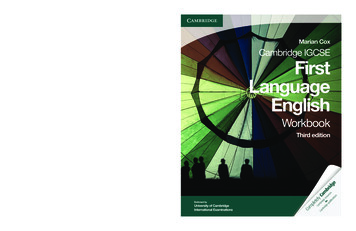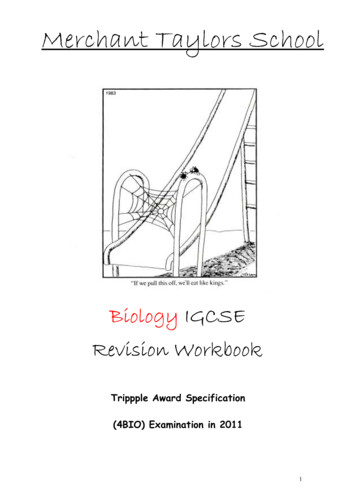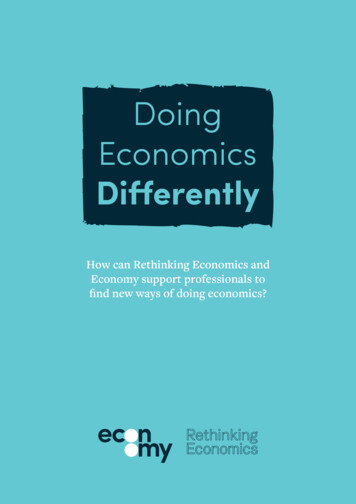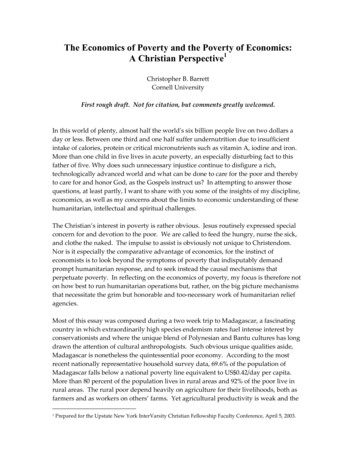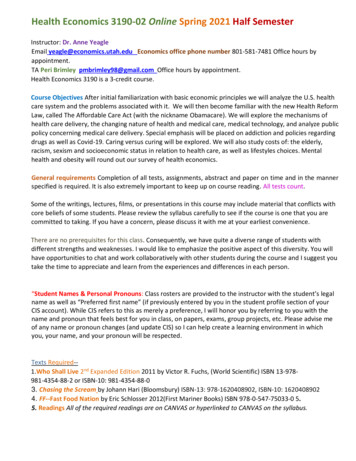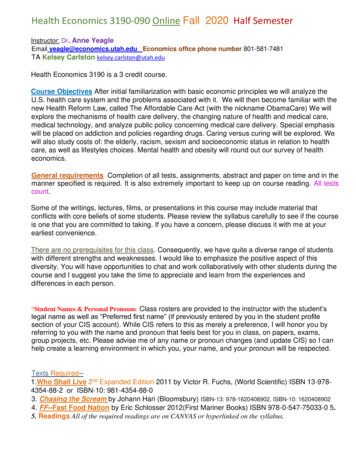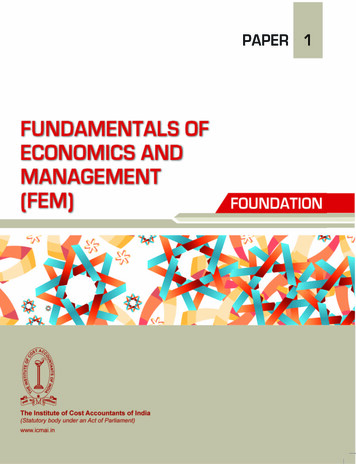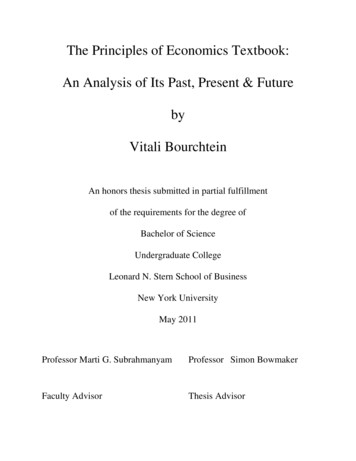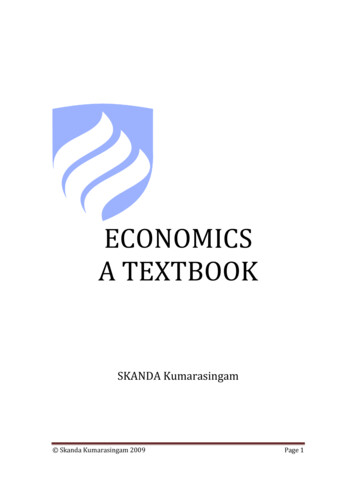
Transcription
ECONOMICSA TEXTBOOKSKANDA Kumarasingam Skanda Kumarasingam 2009Page 1
In memory of my fatherViswalingam Kumarasingam Skanda Kumarasingam 2009Page 2
Contents in BriefIntroductionAbout the AuthorPart 1- Micro EconomicsChapter 1- Basic Concepts and Ideas of EconomicsChapter 2- Price TheoryChapter 3- Price Elasticity and Marginal RevenueChapter 4- Cost of ProductionChapter 5- Product Price and Output in Pure CompetitionChapter 6- Product Price and Output in a Pure MonopolyChapter 7- The Prices and Employment of ResourcesPart 2- Macro EconomicsChapter 8- National Income AccountingChapter 9- Macroeconomic Analysis- Aggregate Demand and Aggregate SupplyChapter 10- National Income AnalysisChapter 11- International Trade and Balance of PaymentsChapter 12- Money and Banking: Fiscal and Monetary Policy Skanda Kumarasingam 2009Page 3
Contents in DetailIntroductionAbout the AuthorPart 1- Micro EconomicsChapter 1- Basic Concepts and Ideas of Economics Problem of scarcity Needs and wants Resources or factors of production Goods and services Efficient economies Production possibilities Law of increasing opportunity cost Efficient and inefficient points on the production possibilities curve Circular flow diagram The economic questions Review (chapter summary) Answers to review questionsChapter 2- Price Theory Demand Law of demand Differences between demand and quantity demanded( compiling the determinants ofdemand) Supply Law of supply Differences between supply and quantity supplied( compiling determinants of supply) Skanda Kumarasingam 2009Page 4
Demand and supply( finding the market equilibrium for an individual product) Changes in the equilibrium Review( chapter summary) Answers to review questionsChapter 3- Price Elasticity and Marginal Revenue Elasticity and its calculation Revenue Elasticity of supply Marginal revenue Review( chapter summary) Answers to review questionsChapter 4- Cost of Production Economic costs and economic profits Cost schedules and curves Marginal cost and marginal product law of diminishing returns Average costs Long run cost curves Review (chapter summary) Answers to review questionsChapter 5- Product Price and Output in Pure Competition Features of perfect competition and assumptions Short run cost of production The firm’s supply curve Skanda Kumarasingam 2009Page 5
Long run cost of production Review (chapter summary) Answers to review questionsChapter 6- Product Price and Output in a Pure Monopoly Features and assumptions of a pure monopoly Short-run cost curves Long run cost curves Review ( chapter summary) Answers to Review questionsChapter 7- The Prices and Employment of Resources Types of resource employers and their markets Perfectly competitive resource employers selling in a perfectly competitive environment Perfectly competitive resource employers selling in an imperfectly competitive environment Important features of a perfectly competitive resource market Monopsonists Firms where all resources are variable Review questions Answers to review questions Skanda Kumarasingam 2009Page 6
Part 2- Macro EconomicsChapter 8- National Income Accounting Purposes of national income accounting Gross domestic product Adjusting for gross domestic product Review( chapter summary) Answers to review questionsChapter 9- Macroeconomic Analysis- Aggregate Demand and Aggregate Supply The basic ideas of macroeconomic analysis Aggregate demand and reasons for the downward sloping curve Changes in the quantity of real output demanded and changes in aggregate demand Aggregate supply Changes in the quantity of real output supplied and changes in the aggregate supply Equilibrium Inflation and unemployment Review questions Answers to review questionsChapter 10- National Income Analysis The purposes of national income analysis Assumptions Consumption and savings Gross investment Marginal and average consumption and savings Understanding gross investment using graphical presentations Skanda Kumarasingam 2009Page 7
Two sector economy Effects of multiplier Open economy with foreign trade Government expenditure and taxes in an open economy Review questions Answers to review questionsChapter 11- International Trade and Balance of Payments Fundamental questions of trade Law of comparative advantage Importance of specialization Terms of trade Foreign exchange Law of demand and supply for foreign exchange Balance of payment Review( chapter summary) Answers to review questionsChapter 12- Money and Banking: Fiscal and Monetary Policy Roles of money Components of money and money-supply Demand for money Equilibrium money-supply and demand Commercial banks The commercial banking system Federal Reserve Bank Policies Skanda Kumarasingam 2009Page 8
Review (chapter summary) Answers to review questions Skanda Kumarasingam 2009Page 9
IntroductionThis book is like no other.I say this boldly because as a teacher and lecturer in economics for over ten years at Post-graduateand Under-graduate levels I am yet to see a book of this nature. We know that the average economicsbook will have about 500 pages or more (some over a 1500 pages) and most of them would includeover explanations, repetition, articles, information, case studies, examples or metaphors which onlygo to confuse the simple concepts that we need to be aware of so that we will be able to evaluate thisworld better from an economic standpoint. After all this has always been the core objective ofstudying economics in all most all courses.If you think critically you will see that in many subjects to understand it better you need tounderstand the concepts only. Once the concepts have been clearly understood the topics and theoverall subject becomes easy to digest.Understanding core concepts has become the new way of super-learning. One method of superlearning suggests that a teacher (or facilitator) should only be involved in spending about 10 percentof their time that is given to lecture an economic course (or any course for that matter) explainingonly the core concepts well. Once the concepts have been well understood the student will then beable to read any chapter and be able to understand it well. However when the overall concept or thepicture is not given the student will have to laboriously go through an economic text book whichoften looks as big as a dictionary to unearth the concepts. Most often they give up and muddlethrough with little understanding of the topics or overall subject. Their intention then becomes knowsomething to just pass the examination.As previously explained as a teacher, lecturer and facilitator for over 10 years teaching not onlyeconomics but many management, accounting and finance related subjects I have realized that thereremains a huge gap in books which explain the concepts very clearly and fast.In this book I have just done this and this is why I say that this book is like no other. In nearly 10 daysat the most you will be able to go through this book very quickly which consists of just 150 pages oftext explaining to you very clearly and succinctly the key points and core concepts of this ratherconfusing and difficult subject. The rest of the pages (approximately around 75 pages more) includepictures and diagrams to explain the concepts even better. Eventually you will not even have to readthe notes. Just look at the pictures, graphs and schedules to understand the whole subject. Then readthe review or summary at the end of the chapter to tie up all loose ends. Once the concepts have beengrasped you will be able to tackle your complex economics textbooks that have been oftenrecommended by university professors in a fairly easy manner.So in this book I have avoided explanations of certain unnecessary areas, padding it with casestudies, paper articles and long drawn examples. However I have used clear examples to explain theconcepts extremely well. Note that this book is not a short notes book in economics. Each concept orkey point has been explained very clearly.All of us understand that people learn well when given the information or the data in very smalldoses. The small steps that you take will seem simple and familiar to you. Developing on these basicideas we will then move towards more complex often perplexing and unfamiliar ideas. In this wayyou will be able to grasp very difficult and complex ideas in economics fairly simply. You will alsonote that this concept book has been developed in such a way so that every paragraph will highlightsmall but new information. In the following paragraph a new idea or concept is developed based onthe idea in the previous paragraph, schedule or curve. Skanda Kumarasingam 2009Page 10
All of us consider that people learn better when they are actively involved. To get you activelyinvolved it (the book) asks you to fill schedules', draw graphs and pictures and write your ownobservations before it is told or taught. Try not to look at the suggested answers or completedschedules provided just below the activity until you have made genuine effort completing it. Theanswers are given just after simply because I do not want to waste your time by asking you to checkat the end of the book for the answers. In this way you will realize that economics is easy to studyand understand. You also analyze and synthesize the subject as you move along.This book has been written in such a manner so that it will work as your personal tutor. So first it willtell you about certain concepts, then ask you about them and finally answer it or correct it. Say forexample first it will explain a simple concept then ask you to fill a schedule or draw a graph orpicture or write your observations. Then I will give you the right observations so that you can checkyour understanding as you go along. Since this is your personal trainer you are not obliged to workfast. The concepts are easy to understand and it is believed that you should work at your own speed.Somehow if you are hard pressed for time you can still go through the whole book in less than 10days and you will have all the concepts you need to know about economics at your fingertips. Pleaseremember that the essence of learning is understanding and mastering these concepts very well.Once the concepts are embedded into your mind you will be able not only to understand but alsoanswer all questions using your intelligence remembering to blend it with the theoreticalframeworks.You should note that this book has been written in such a way as people generally talk. So the readingis less strenuous and easy to understand. As far as possible I have not used jargon. However like allspecialized subjects jargon is necessary evil and so has introduced such words but first explainingthem in simple English.At the end of the chapters there are a series of review tests. These review tests are simple questionswhich you will be able to fill out fast. These will highlight all the major points that you need to knowand will help you to round-off or tie up the knowledge you have gained by studying the specificchapter. This is indeed your chapter summary. So I have not provided a chapter summary. You havewritten one yourself.I believe that this book should have a wide readership. This has been written with a lot of focus onstudents who will be exposed to the subject for the first time or being introduced to the subjectbefore have not really grasp the ideas or the concepts well. This can involve advanced level students,students taking bachelor's courses where economics is a subject, professional examinations andthose studying for their Masters of Business Administration. Particularly those who are studying fortheir Masters of Business Administration come from many fields such as medicine, engineering andthe arts. These students generally were never taught economics before. At the master's level thesubject is taught at its most complex offering and those who have not understood the subject well ordo not understand the concepts well are forced to study a fairly complex economics test book havingabout 500-1500 pages making the concepts impossible to understand in the process. We also knowthat students are hard pressed for time and there is a dearth of good economics lecturers andteachers. I believe that this book will be the answer to such readership.However to obtain complete knowledge about economics this book on concepts is insufficient. Thiswill only help to lift the initial fog that surrounds the subject. Once the concepts have been wellunderstood you should read the recommended textbook to obtain a fully rounded understanding. Ibelieve that as you seek to understand the world where we are all time poor with a great yearning forsimplicity this book serves its purpose well. I hope that this book will benefit you by helping you toprune the many trees that may temporarily block your vision and enable you to behold a singlecoherent forest.Skanda KumarasingamSydney Australia 31 December 2009 Skanda Kumarasingam 2009Page 11
About the AuthorSkanda Kumarasingam was a facilitator to many distinguished foreign Masters andBachelors programmes offered in Sri Lanka by the American Central University (USA),American City University (USA), Troy State University (USA), University of Manipal (India),Curtin University of Technology (Australia) and Leeds Metropolitan University (UK). Healso possesses vast primary research skills and has supervised over thirty five theseswriting for MBA programs.He was a corporate coach specializing in finance, operations and change managementthrough the Centre for International Education and Training from the Torrens Valley TAFE–South Australia and EdExcel of UK.In the past Skanda lectured/facilitated study programs leading to the professionalexaminations conducted by the Institute of Chartered Accountants of Sri Lanka, Society ofCertified Management Accountants of Sri Lanka, Association of Accounting Technicians ofSri Lanka, Sri Lanka Institute of Marketing, Chartered Institute of Marketing (UK),Association of Business Executives (UK) and Institute of Chartered Secretaries andAdministrators (UK).Skanda counts over 10 years of lecture and facilitation experience. Before becoming fullyinvolved in education he was a senior manager and professional primarily in generalmanagement and management accounting roles either with profit centre responsibility orin supporting senior managers with profit responsibilities. He has held senior managementroles in KPMG (Audit and Consulting), Coke (Regional Internal Auditor and LeaderFinancial Impact Teams in the Asian Region), PepsiCo, Marks and Spenser (UK) ,Gap(Singapore), Next (Singapore) and Ernst and Young (Business Training CentreKingdom of Bahrain). Skanda Kumarasingam 2009Page 12
Skanda has over 15 years experience in senior management and professional business training roles.During this period Skanda developed many tools and techniques to aid management in managing andcontrolling costs and improving profits. His models which include the Profit Maps (for profitimprovement and cost reduction) and the LEAST Tax Model (for proactive tax planning) have beenwidely used in many organizations and its branches and sub-units saving them large amounts ofdollars in costs and dramatically improving profits.Skanda is a qualified Chartered and Management Accountant. He earned his MBA from theUniversity of Lincoln UK. He has many professional qualifications in Quality Management,Supply Chain Management and Taxation.Skanda is the author of four books - The Profit Maps Model, The Profit Maps ModelWorkbook, Personal Tax Planning and Economics- A Textbook. The first two books havebeen used in workshops and training sessions by him with great success. These two booksand the Personal Tax Planning book have been widely distributed in e-book form and madeuse by many organizations and individuals. The Economics textbook was adopted in manyteaching institutions where Skanda was a lecturer. All these books are available free forreading (without abbreviation) in the Scribd website.His ideas on profit improvement cost reduction can be found on his byemailonskandak@profitmaps.com.au.Skanda lives with his wife Anne and two daughters Ramita and Sahana in Sydney, Australia. Skanda Kumarasingam 2009Page 13
Part 1- Micro Economics Skanda Kumarasingam 2009Page 14
Chapter 1Basic Concepts and Ideas of EconomicsLearning Outcomes To understand the basic economic terms and concepts such as scarcity, unlimited needs andwants, resources in economics, goods and services and to develop a basic definition ofeconomics as a science To appreciate the role or contribution of the study of economics in creating efficienteconomies Understanding the concept of production possibilities and using it to learn the law ofincreasing opportunity cost To develop a simple understanding of a society or economy using the circular flow diagram.More complex versions are developed later in this book. Understanding the meaning and relevance of the economic questions that every society mustanswer Summarize what was learnt in this chapter by asking relevant questions in the reviewsection to tie up all the loose ends. Using the answers that have been provided subsequentlyto these review questions you will have a complete and comprehensive summary to studythis chapter.Chapter Outline Problem of scarcity Needs and wants Resources or factors of production Goods and services Efficient economies Production possibilities Law of increasing opportunity cost Efficient and inefficient points on the production possibilities curve Circular flow diagram The economic questions Review (chapter summary) Answers to review questions Skanda Kumarasingam 2009Page 15
Scarcity (The Theme of Economics)Let us say for example a college student has the following expenses for a given month in y030Miscellaneous expenses 020Total330However the above college student has only USD 300. From this we can note that the availableresources or money that she has is limited compared to her needs. So we can also say that theavailable resources are scarce compared to her needs.The problem facing this college student is not at all uncommon. Everybody in the society faces thisproblem. This problem that the society faces is that its needs and wants are unlimited compared tothe scarce resources that are available in society. This problem is called the problem of scarcity.Because of this economics is the study of understanding and solving the problem of scarcity. In facteconomics is also defined this way.Needs and WantsThere is however a difference between needs and wants. Needs are goods and services that peoplerequire so that their basic requirements are met and that they will be able to survive in society.However once their basic needs are met they tend to become much more desirous of wanting goodsand services which are not required for survival but may be required for purposes of status etc. Therequirement for such products and services are called wants.Resources are Factors of ProductionWe also need to understand that scarce resources need not always be money. In economics scarceresources are basically the factors of production which include land, labor, capital andentrepreneurship. The scarce resources are used to produce the goods and services that the societywants.Goods and ServicesGoods and services can be tangible or intangible. Tangible goods are those which you can touch andfeel such as a pound of bread or a table or chair. Intangibles are services such as getting a haircut orcleaning your teeth from a dentist. Services cannot be touched but can only be felt and so are calledintangibles.Some goods are also called free goods when given by nature and available in abundance and free touse. Nobody owns them and they are not transacted in a market. Sunlight and river and sea watermay be examples of this. On the other hand economic goods are owned by somebody, transacted in amarket and not available in abundance. All economic goods (consumer goods and capital goods) areexamples of economic goodsEfficient EconomiesIf a society needs to reduce the gap between its unlimited needs and wants and the products orservices it can produce based on the scarce resources it has it should become a very efficienteconomy. Such an economy is called a fully efficient economy. But we need to know that even in a Skanda Kumarasingam 2009Page 16
fully efficient economy even though we may be able to produce more goods and services we still willnot be able to meet human demands which are unlimited. All that we are saying is that we will beable to reduce the gap if society is fully efficient.Next we need to consider what we mean by an efficient economy. Efficient economies are capable ofproducing more goods and services by their capability of using all resources that are available so thatthere are no idle resources. Also note such a society should be able to use the best availabletechnology to produce the goods and services.In a society which is capable of using all its resources and that there are no idle resources such asociety is called a society which has full employment. You should note clearly that as far as economicsis concerned full employment not only means full employment of labor but full employment of all theresources (factors of production) that are required to make goods and services.Technology is the means or methods that are used by businesses to convert inputs to outputs. Asociety should use the best available technology to produce its goods and services and if it does sosuch a society is called as having full production.You are thus required to note the subtle difference between full employment and full production verycarefully.So we can summarize that a fully efficient economy full employment full productionProduction PossibilitiesDue to the concept of scarcity there are certain other ideas in economics which we need to beintroduced to. To do this well we need to first understand what we mean by the productionpossibilities curve or production possibilities frontier or production possibilities schedule. They allmean one and the same.Given below is a production possibilities schedule. This is prepared assuming that the economy is afully efficient economy and so all the resources are used and the best possible technology isemployed. Also the production possibilities schedule is prepared for a period of time when resourcesor technology will not fproducing foodOpportunitycostofproducingclothesThis also tells us that this economy produces two kinds of goods which are food and clothing. Thiseconomy is capable of producing different combinations of food and clothing and these combinationsare given from A to K. We can also observe that at any combination such as at combination C this Skanda Kumarasingam 2009Page 17
economy is able to produce 2 units of food and 96 units of clothing using its fixed resources andtechnology at this given time.We also note that as the production of food keeps increasing the production of clothing has to reduceand vice versa. This is because as assumed the resources are fixed so to produce more food we needto shift resources from clothing to the production of food. Because of this shift production of clothingwill obviously reduce.It is also clear that to produce more of something we need to give up the production of somethingelse. So we need to make a choice. Wherever there are choices to be made there is obviously a cost. Ineconomics this cost is called an economic cost. All economic costs are opportunity costs. Opportunitycost means what you give up to get something.In the above schedule we can say that the opportunity cost of producing food is how many units ofclothing you will have to give up. Similarly the opportunity cost of producing clothing is how manyunits of food you will have to give up.For example to produce one unit of food (say from point A to Point B) we need to give up theproduction of clothing by one unit. So the opportunity cost of producing one unit of food is one unitof clothing that was given up. Using this explanation you are now required to fill up all the blanks(the last two rows) in the above scheduleWhen you completed the last two rows of the production possibilities schedule it should be like thisCombinationsProductsABCDEFGHIJKFood123456789 10Clothing100999691847564513619Opportunity cost of1357911131517 19producing foodOpportunity cost of1.00 0.33 0.20 0.14 0.11 0.09 0.08 0.07 0.06 0.05producing clothesYou might now ask which is the best combination of all the combinations that have been given in theproduction possibilities schedule. The production possibilities schedule does not reveal which is thebest combination but it only reveals what combinations are possible given the resources andtechnology at a particular time when these are fully employed and technology is at full production.Law of Increasing Opportunity CostsWe can also note from the completed production possibilities curve above that when productionincreases of a particular commodity the opportunity cost also increases. This is called the law ofincreasing opportunity costs.Let me now explain why the law of increasing opportunity cost is true. Let us say for example in ourhypothetical economy or society that has been depicted by the production possibilities scheduleabove we have 100 laborers and half of this labour is involved in the production of clothing and theother half in the production of food. We also assume that those who are involved in the production offood are experts in its production and those who are involved in the production of clothing areskilled in their own field. Let us also say that the other resource which is capital includes 50 sewingmachines and 50 tractors. The 50 sewing machines obviously are involved in the production ofclothing and 50 tractors are involved in the production of food. Skanda Kumarasingam 2009Page 18
Now if we move from one combination to the other we need to also shift these resources. Howeverwe also know that these resources specialize in the production of either food or clothing. When wewant to produce more of clothing we will then shift most of the resources which are capable ofproducing food to the production of clothing. This will obviously be inefficient as those who areexperts in the production of food will be incompetent in the production of clothing and that tractorscannot be used in the production of clothing. Another thing that we see is that the increased labour inclothing will now be using the limited number of sewing machines that are available and so will haveto wait for a long time until a machine becomes free for them to use. This will also make them moredisorganized. So even though we know that production increases when more resources are used weneed to shift more and more resources to produce this increase. This explains how the law ofincreasing opportunity cost works.Efficient and Inefficient Points on the Production Possibility CurveUsing our production possibilities schedule let us now prepare a production possibilities curve. Forno obvious reason let us plot food on the Y axis and clothing on the X axis. Now draw this graph in thespace provided below. On this graph note combination F as indicated on the production possibilitiesschedule.To the left of this production possibilities mark a point L. We can easily say that point L is a possiblecombination that can be achieved but it is inefficient. The more efficient production will involvemoving this point towards the production possibilities curve. Note that to become fully efficient weneed to move towards the production possibilities curve and the opportunity cost of doing this iszero. The only reason why we are unable to achieve this is because there are either unemployedresources or underemployment of the right technology. If we are able to overcome this problem ofunemployment of resources or the underemployment of technology we will be able to move towardsthe most efficient production point which is on the production possibilities curve at the given time.We can also mark a point M which is on the right side of the production possibilities curve. Weshould note that this point is impossible to achieve with the fixed resources and the given technology.The only way the production possibilities curve can shift or move towards point M is if it shiftsoutwards to the right. This will take time to achieve and can only be achieved by increasing theresources or improving technology so that such technology will be able to increase output for oneunit of input.We also know that the production possibilities curve is a negative curve. We say the graph is negativewhen the relationship is an inverse relationship. This relationship can be noted by finding out whatthe opportunity cost is. The opportunity cost can be derived by calculating the slope of this curve. Skanda Kumarasingam 2009Page 19
Slope of any curve is calculated as rise over run(Y axis over X axis). You will also note that if youcalculate opportunity costs at different points that it is not constant but increasing as the law ofincreasing opportunity cost dictates in any given society.Your completed production possibilities graph should look like thisProduction 0110clothingCircular Flow DiagramLet us now try to draw this diagram in the space below using the information and descriptions thatare provided. Read them carefully and you will be able to develop a very good understanding of howcertain essential ideas of economics operate. Skanda Kumarasingam 2009Page 20
Draw 2 boxes and label one as business firms and the other as householdsInside
of their time that is given to lecture an economic course (or any course for that matter) explaining only the core concepts well. Once the concepts have been well understood the student will then be able to read any chap

